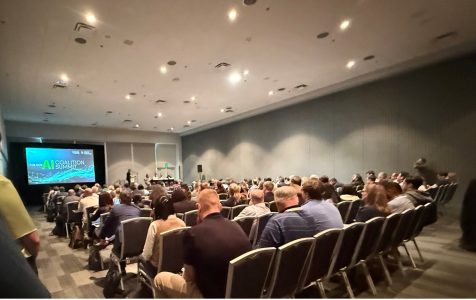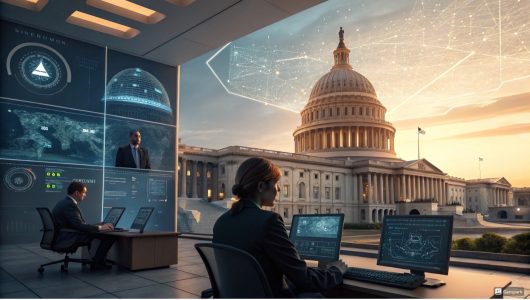Widgetized Section
Go to Admin » Appearance » Widgets » and move Gabfire Widget: Social into that MastheadOverlay zone
Multi-Agent Systems (MAS): The Prediction of GenAI in 2025 & Its Impact in Local Government Settings
The views expressed are those of the author and do not necessarily reflect the views of ASPA as an organization.
By Thuong “Annie” Bui
January 13, 2025

At the GovAI Coalition Summit last December in San Jose, California, I had the opportunity to witness inspiring conversations about the future of artificial intelligence (AI) in public service. Among the standout presentations was the concept of multi-agent systems (MAS). While it might sound complex, this approach holds significant potential for 2025. MAS could help local governments to improve services for our community, whether by reducing wait times for public transit or enabling faster emergency responses. So, what is MAS, and how can local governments use it to make a difference? Let’s explore together!
What Is a Multi-Agent System (MAS)?
But first, what is an AI agent? According to IBM, it’s a system or program that can independently complete tasks for a user by planning its workflow and utilizing available tools.
Now, imagine a MAS as a team of AI models working together toward a common goal. Instead of relying on a single model to handle everything, a MAS employs multiple AI agents, each with its own area of expertise. For instance, one agent may excel at data analysis, another at language translation and a third at generating codes or reports. By collaborating, these agents can solve problems faster and more accurately while offering greater adaptability and scalability than any single agent could achieve alone.
This setup is like a high-performing team at work, where collaboration leads to better results than working solo. These AI agents “communicate” with each other, share learned experiences and adjust their strategies based on new information: all in real time!

One interesting examples of this technology is Mixture of Agents (MoA), which enables multiple large language models (LLMs) to collaborate in real time for enhanced performance. In December 2024, Genspark, a Microsoft partner, announced its own MoA tool. This came about six months after Junlin Wang (Duke University) and the Together AI team published their groundbreaking research. Their findings showed the impressive potential of MoA, which outperformed even the most advanced standalone systems.
MoA, however, highlights just one way MAS leverages collaboration among LLMs. Now, let’s explore how this technology could be applied in local government settings:
How can local governments use multi-agent systems?
- In public transit optimization, MAS could manage public transit systems in real-time by coordinating data from traffic sensors, passenger counts and incident reports. Agents act as “decision nodes” that adjust bus or train schedules dynamically based on real-time demand and road conditions. For example, MAS can reroute buses in a metropolitan area during accidents or special events to minimize delays and prevent overcrowding.
- In emergencies, MAS could integrate data from public safety agencies, healthcare facilities and transportation systems to provide government officials with real-time insights. These agents collaborate to simulate crisis scenarios, suggest optimal evacuation routes and identify resource bottlenecks. For example, during a hurricane, MAS can suggest the best evacuation routes based on real-time traffic and shelter availability.
- In healthcare, MAS could predict resource needs during public health crises by analyzing real-time data on disease spread, population density and resource availability. Therefore, the agents could ensure critical supplies reach high-demand areas, preventing shortages and optimizing response efforts.
While the potential is enormous, we are not there yet. The ideal MAS would seamlessly access multiple datasets, APIs and memory systems at once, essentially creating an ecosystem where different tools work together effortlessly. The good news? We are making progress, and local governments have an opportunity to be part of this journey.
What Can We Do Now?
- Government agencies don’t need to tackle MAS adoption alone. Collaborating with universities, startups and other municipalities can foster innovation and co-develop MAS pilot programs tailored to public needs.
- Like other AI tools, MAS success depends on public employees feeling confident using new tools. Many may be uncertain about AI’s role in their work, so training and transparency are essential.
- Public trust is crucial for any AI initiative. Residents need to know their data is safe and that AI supports human decision-making rather than replacing oversight. Therefore, it is important to regularly share updates in town hall meetings, address concerns and showcase improvements like faster service or improved emergency response.
Embracing the Future
I humbly predict that multi-agent systems will be an exciting frontier in 2025. By working together, these systems can boost efficiency, improve responsiveness and scale solutions to meet community needs.
Yes, challenges like system coordination and maintaining transparency are real, but the potential is undeniable. With thoughtful leadership, strategic partnerships and a focus on training, local governments can use MAS as a partner in serving their communities better.
Lastly, let me empathize this again: the future is not about replacing human roles. It is about empowering us to make an even greater positive impact where it matters most!
Author: Annie Bui is a Doctoral Candidate in Public Administration major, where her research focus on the integration of GenAI in Local Governments. She is the current President of Student Public Administration Association (SPAA) at University of La Verne. At the same time, she works for Small Business Development Center (SBDC), a non-profit organization funded by Small Business Administration, provides zero cost one-on-one consulting services to entrepreneurs for their new and existing businesses. As both a researcher and a practitioner, she committed not just to discussing theories but to actively seeking comprehensive resources that enhance our understanding of how to leverage this technology effectively in the public sector – a sector traditionally slower to adopt technology than the private sector. Her aim is to explore practical solutions that help public leaders to catch up with this fast-changing technology by being ready and proactive in adopting it. Her monthly article series will cover various topics related to GenAI in the current local government settings. Each article is designed to give government agencies the essential knowledge and tools to prepare for an effective and responsible GenAI adoption.






Follow Us!